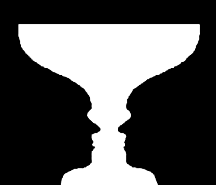My senses give me information about the world. Even science, with its worship of objectivity, still requires a human being to have the subjective experience of the senses to conduct experiments and judge the results.
These senses are widely recognized to be limited and fallible.
Each of my senses is sensitive to only a tiny sliver of what is potentially available to it.
For example, the colors that I can see are only a small part of the the "electromagnetic spectrum." I do not see ultraviolet, infrared, microwaves, X-rays, and many others, even though they are, in a sense, colors.

Other living creatures can see slightly differently from me. Some insects do see ultraviolet, and a flower that appears to be one color to me, can look like a bullseye pattern to them. Hawks and other birds of prey can see a mouse sharply and distinctly from hundreds of feet in the air. Most animals see only shades of grey, not the colors I perceive. Even among humans, some people are colorblind, and cannot tell green from red; obviously the colors they see are much different from the ones I see.
Another example is that there are many things too big or too small to see. Stars are nothing like the small dots they appear to me. I cannot see the bacteria and other life that I know are teeming everywhere around me.
Similarly, the sounds I hear are a small fraction of the sound waves in the air. Dogs can hear much higher sounds; elephants and whales can hear much lower sounds. The senses of taste and touch are similarly limited.
In addition to the traditionally defined five senses, scientists have identified two others in humans. One is the sense of balance (the knowledge of which way is up), and the other is the sense of position (where the parts of the body are located, even if nothing is touching them). Some biologists have suggested that migratory animals possess another sense, a sort of inbuilt magnetic compass that tells them which way is north.
My senses give me a very limited picture of the world. In every case, what they don't tell me is greater than what they do tell me. It just so happens that what they do tell me is enough for me to get by in the world.
My sensory experience may seem like an unbiased mirror reflecting an external reality, but the human mind contains an unconscious director of sorts putting together the movie of my experiences, editing out parts here, adding parts there.
Although my senses only detect a tiny part of reality, even that tiny part is too much for my consciousness to handle. The preconscious brain edits the sensory experiences before they are presented to my consciousness.
For example, it is common to hear that the colors I see correspond to the wavelengths of light hitting my eye. In actuality it is more complicated, and the preconscious brain uses the entire image to determine what color each particular part will appear to be.
To see this more clearly, look at the following image. All the dots are white, but as I move my eyes across the image, they appear to blink between black and white. The light frequency doesn't change; my brain's preconscious processing of the raw image does.

Another example: the preconscious brain detects edges in the image, and makes them stand out more. Take a look at the following image, then put your finger over the edge in the middle to see how it affects color perception.

At the same time as a visual image is presented to consciousness, meaning is also presented. When I see the word "cat" on a page, I do not consciously think, "that collection of shapes means the thought of a cat." The thought of "cat" immediately springs to mind upon seeing the word, which is merely certain shapes that I have learned to associate with the idea of a cat.
Does the image below show black faces on a white background, or a white vase on a black background? In truth, it shows neither; it is just black and white blobs. But the preconscious brain searches for meaning in the blobs.

An even more impressive example involves the experience of time. If two dots alternately blink on and off next to each other slowly, a person will see them as two blinking dots. However, if the dots blink quickly, the person sees one dot moving from side to side! The preconscious mind 'fills in the gap' between the two dots. Even more intriguing, if the dots are of different colors, the consciousness still sees one dot, but it changes color in the middle -- before the second dot has even appeared! This does not reflect psychic abilities, but rather that even the flow of time itself is subject to preconscious editing.
(I am unable to present a visual illustration of this effect. Those interested can consult D.C. Dennett's Consciousness Explained, chapters 5 and 6, also quoted in Paul Davies' About Time, chapter 13.)
There are many other examples of preconscious processing of the senses. With hearing, the brain automatically filters out background noise, but highlights "interesting" sounds. The "cocktail effect" is when you are oblivious to a conversation occurring next to you, but as soon as someone in that conversation says your name, your attention is immediately shifted. Scientists have countless other examples of the edited nature of consciousness.
I have found that my senses are easily fooled. Not only do they see stars as tiny dots, and are preconsciously edited, but many times I have looked at something, and then when I saw it from a different angle, realized that I had totally misinterpreted it.
Because light moves at different speeds through different substances, light can "bend" or "refract" causing peculiar visual effects. If I put a stick halfway into water, the stick looks bent; in the summer heat, I sometimes see a mirage of nonexistent "water" on the road ahead of me. In some areas, mirages (from the French word for "seeing one's reflection in a mirror") are even more spectacular, with ships appearing to float in the air, the setting sun appearing to be square, and lighthouses appearing to rise from the water. These images are confusing if I assume that what I see is what is "really out there." What I see is a pattern in my mind.
Our sense of touch can also be fooled. Many people who have had a limb amputated feel itches in the missing limb. Another example is the feeling of hot and cold, which seems to measure temperature, but does not. If I touch a piece of metal and a piece of cloth in the same room, the metal feels colder, even though both are the same (room) temperature. The sense of touch actually relates to heat flow. Because metal conducts heat better than cloth does, more heat flows from my finger into the metal, and it feels "colder."
Further, all my senses are merely electrical and chemical impulses in my brain. It would be possible to create everything I perceive with the right combination of electrical impulses, and I would have no way to distinguish true reality from the virtual reality built for me.
Next: Like a Brick House
For Further Exploration
The technically minded and curious can browse these sources elsewhere on the Web:
